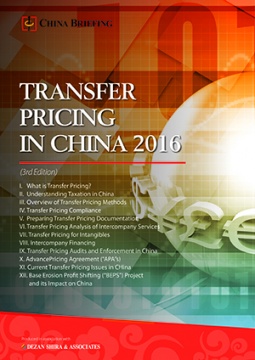China Clarifies Tax Treatment of Indirect Asset Transfers
By Steven Elsinga, Legal Editor and James Zheng, Senior Tax Specialist at Dezan Shira & Associates, Shanghai
The Chinese government has been paying close attention recently to the effects of offshore entities having ownership or control of Chinese companies or assets. Following the release of the draft Foreign Investment Law in January 2015, the State Administration of Taxation (SAT) issued a Bulletin on the tax treatment of Chinese assets that are transferred indirectly. The Bulletin was made on February 3, 2015 and went into effect immediately.
The Bulletin is a clarification of a policy first initiated in 2009, stating that the indirect transfer of Chinese equity is taxable as well. A direct transfer is when one sells shares in a Chinese company to another company or individual. If an investor sells shares at a higher price than the one they were bought for, the investor makes a profit. This profit is subject to capital gains tax in China.
Prior to the 2009 policy, investors tried to avoid this tax by having an offshore holding company own the Chinese company. Instead of directly selling the Chinese company’s shares, the investor would sell the shares of the offshore holding company that owns the Chinese company. This way the shares of the Chinese company didn’t change owners – it continues to be owned by the holding company – so the investor would not have to pay Chinese capital gains tax. In such a transaction, the offshore company would often be in a country that does not levy capital gains tax at all – resulting in a tax free profit for the investor.
To put a stop to this practice, the SAT issued a Circular in 2009, stating that where Chinese equity is indirectly transferred like this, without a reasonable commercial purpose, the Chinese tax authorities will treat it as if it were directly transferred – and levy tax accordingly.
The move mainly affects foreign companies looking to acquire China-based companies, such as private equity and venture capital firms, as well as multinationals looking to enter the Chinese market through mergers or acquisitions. Multinationals that have an entity in China as part of their corporate group need to pay attention as well.
![]() RELATED: Issues Affecting Cross-Border Mergers and Acquisitions in China
RELATED: Issues Affecting Cross-Border Mergers and Acquisitions in China
The new Bulletin was issued to clarify some of the confusion that has since arisen as to the meaning of a ‘reasonable commercial purpose’, the application to real estate and assets belonging to establishments, and what exceptions there are.
Determining the ‘Reasonable Commercial Purpose’
Importantly, the Bulletin clarifies what is considered a reasonable commercial purpose. Instead of having a single defining factor, the Bulletin lists a number of elements that may contribute to the transaction having a reasonable commercial purpose. The official explanation accompanying the Bulletin emphasizes that more than one factor needs to have been met. Single or partial factors will not suffice. These factors are:
- Whether the main value of equity in the foreign entity is made up of taxable assets in China.
- Whether the assets of the foreign entity are mainly comprised of investments in China, or whether its income is mainly sourced from China.
- Whether the corporate structure has economic substance, from the point of the functions the foreign company is performing, and the risk it is bearing. This is commonly assessed by looking at the related companies’ equity structure, assets, staff arrangements, income and other operational information.
- The length of time the foreign company’s business model, shareholders and organizational structure have been in existence. The official explanation reveals that the tax authority will look for ‘traces of a plan’ to avoid tax by indirect transfer. It gives the example of an intermediary company being set up shortly before the indirect transfer. This would be a clear red flag that the investor is trying to evade tax by use of foreign corporate structures.
- Whether foreign tax is being paid on the transaction. The tax authorities will assess whether the transaction is resulting in a cross-border tax advantage, looking at both the party transferring and the one receiving the shares. If the tax burden is less than what would have been paid in China, this would flag the tax authorities.
- Whether the transaction could have been substituted by a direct transfer. The tax authorities will consider a variety of matters to determine whether not transferring assets directly serves a reasonable business purpose, such as market access, the need for a review of the transaction, compliance requirements for the transaction and the goal of the transaction.
- Whether China has a Double Taxation Avoidance Agreement with the states in question, or other tax reducing arrangements relevant to the case.
- Other matters deemed relevant.
![]() RELATED: China Moves to Curb Transfer Pricing – Effective Immediately
RELATED: China Moves to Curb Transfer Pricing – Effective Immediately
Certain transactions are automatically deemed to not have a reasonable commercial purpose:
- 75 percent or more of the foreign entity’s income is derived from taxable assets in China.
- If at any time in the year before the transaction, 90 percent or more of the foreign entity’s asset value (excluding cash) is comprised of assets in China.
- The foreign company performs only limited functions and bears only limited risk, and while being fully incorporated according to the jurisdiction’s laws, does not have economic substance. This clause is a clear targeting of shell companies and similar arrangements.
- The overseas tax burden on the transaction is less than what it would have been with a direct transfer.
Exceptions
There are three exceptions where an indirect transfer is not flagged, and the investor can safely make the indirect transfer without incurring Chinese tax liability:
- The trading of listed shares on a public exchange.
- When the income would be exempt from Chinese tax under an applicable tax treaty or arrangement had the transaction been direct.
- In the case of a reorganization of a corporate group, where
- the transferring company owns over 80 percent of the shares of the receiving company;
– or vice versa;
– or a third company owns over 80 percent of the shares in both the transferring and receiving company. - the transfer would not result in a lower tax burden in China.
- the receiving company fully pays for the transfer with its own equity.
- the transferring company owns over 80 percent of the shares of the receiving company;
Real Estate and Assets Belonging to Establishments
With the new Bulletin in force, the indirect transfer of real estate in China, and assets attributed to an establishment in China are now also covered. The Chinese tax office may now also regard indirect transfers of these assets as if they had been transferred directly – and tax the transaction accordingly.
 RELATED: Tax and Compliance Services from Dezan Shira & Associates
RELATED: Tax and Compliance Services from Dezan Shira & Associates
Reporting the Transaction
Importantly, the new Bulletin states that the reporting of the transaction is voluntary, and that both the transferring and the receiving party may report the transaction.
Withholding Tax
Usually, the company paying the relevant sum for the shares (most often the party receiving the shares) shall withhold the tax due on the transaction. This amount needs to be paid within seven days of the transaction. If the withholding agent fails to do so, the tax authorities will pursue the matter in accordance with tax laws, but if the required documents are submitted within 30 days, a fine may be waived or reduced.
![]() RELATED: Calculating and Filing Withholding Tax in China
RELATED: Calculating and Filing Withholding Tax in China
If the withholding agent fails to pay the tax, daily interest will be imposed on the transferring party (note: not the withholding agent), apart from the fine and the tax amount due.
|
Asia Briefing Ltd. is a subsidiary of Dezan Shira & Associates. Dezan Shira is a specialist foreign direct investment practice, providing corporate establishment, business advisory, tax advisory and compliance, accounting, payroll, due diligence and financial review services to multinationals investing in China, Hong Kong, India, Vietnam, Singapore and the rest of ASEAN. For further information, please email china@dezshira.com or visit www.dezshira.com. Stay up to date with the latest business and investment trends in Asia by subscribing to our complimentary update service featuring news, commentary and regulatory insight. |
![]()
 Transfer Pricing in China 2016
Transfer Pricing in China 2016
Transfer Pricing in China 2016, written by Sowmya Varadharajan in collaboration with Dezan Shira & Associates and Asia Briefing, explains how transfer pricing functions in China. It examines the various transfer pricing methods that are available to foreign companies operating in the country, highlights key compliance issues, and details transfer pricing problems that arise from intercompany services, intercompany royalties and intercompany financing.
Using China’s Free Trade & Double Tax Agreements
In this issue of China Briefing, we examine the role of Free Trade Agreements and the various regional blocs that China is either a member of or considering becoming so, as well as how these can be of significance to your China business. We also examine the role of Double Tax Treaties, provide a list of active agreements, and explain how to obtain the tax minimization benefits on offer.
 Double Taxation Avoidance in China: A Business Intelligence Primer
Double Taxation Avoidance in China: A Business Intelligence Primer
In our twenty-two years of experience in facilitating foreign investment into Asia, Dezan Shira & Associates has witnessed first-hand the development of China’s double taxation avoidance mechanism and established an extensive library of resources for helping foreign investors obtain DTA benefits. In this issue of China Briefing Magazine, we are proud to present the distillation of this knowledge in the form of a business intelligence primer to DTAs in China.
- Previous Article La Cina revoca gli incentivi fiscali per gli investitori stranieri
- Next Article China Releases Harshest Food Safety Law in History
























